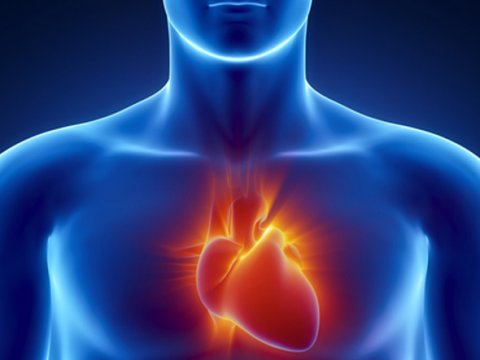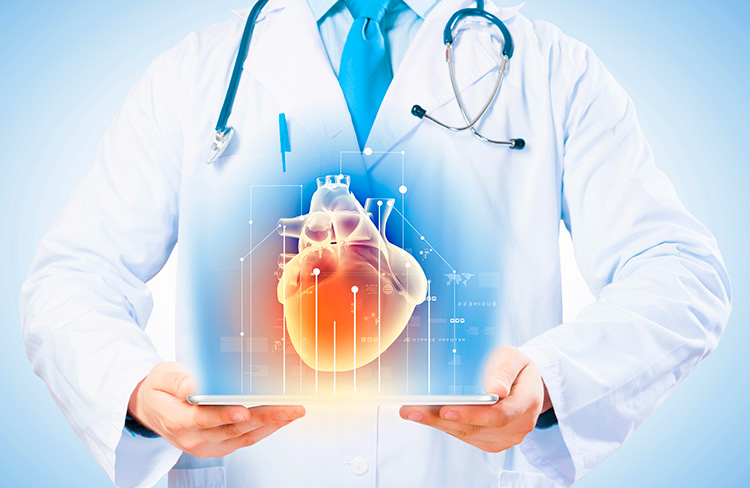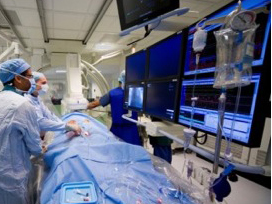I have recently been absent, for the most part, from the community as of late and for good reason. On March 1, 2016 a week before my 55th birthday I suffered a second heart  attack, thanks to the fluoroquinolones. For anyone who missed the story of my first heart attack from 2014, you can read it here.
attack, thanks to the fluoroquinolones. For anyone who missed the story of my first heart attack from 2014, you can read it here.
I have to admit I am starting to develop a case of PTSD due to the hyper-vigilant state that one must remain in while staying in-tune to the nuances of bodily functioning. If it was not for the grace of God and my expertise in my own particular health nuances, I would not be writing this article today. I came close, very close to the irreversible cessation of organismic functioning, yea you guessed it, the proverbial ‘dirt nap.’
At this point a reader may comfort themselves with the thoughts that I am in my mid-fifties and I could have heart disease brought about by lifestyle, genetics, or other natural illness pathologies, but for the most part, you would be wrong. You see, prior to my floxing, I was provably healthy, at least cardiovascular wise. I did not drink, smoke, or engage in otherwise naughty health habits. Arguably, you may have found me a bit boring but I could readily attest that I was not diabetic, I ate healthy, and I would normally bicycle with high intensity 7 to 10 miles every day. Although being six foot four inches tall, I had a 34 inch waist and could bench press 300 pounds. And there’s more…
Four years before my floxing, which occurred at age 46, I had a nuclear cardio stress test and heart scan, because I wanted to increase my high intensity workouts. Being in my early forties, my doctor wanted me to have the test to rule out any abnormalities, such as arterial heart blockages (remember Jim Fix) before I increased my high intensity workouts. The result was a clean bill of health, when it came to my cardio system.
I believe, wholeheartedly, that the initiation of the pathology that manifests such health issues, such as my particular heart attack, was solely the work of the fluoroquinolones, an accusation that I will elaborate on in just a bit, after all, very few take 750mgs of Levaquin for 21 days and come away completely unscathed.
So here I was on March 1st, 2016, a little over two years after my first heart attack, when in the memorable words of the Great Bard’s Francisco in Hamlet “I am sick at heart” or Marcellus’s “Something is rotten in the state of Denmark.” Just like in Hamlet, shortly before midnight I awoke, having gone to bed just 45 minutes earlier. I awoke with some uneasy and dreadful feelings that the discomfort in my chest that I was experiencing might be the evil pain I felt two years prior.
I was tempted to take a Zantac, hoping it was heartburn, and go back to bed, a thought that briefly crossed my mind, I am glad that I instead got up, because had I gone to bed there was a strong possibility that I would have experienced an irreversible loss of personhood. Fortunately I do credit God with giving me the higher state of mind, that inner voice, to wake my wife and have her drive me to the hospital.
For those who are firmly in the “you should have called the ambulance crowd”, like I have said before, we live in a remote area where the closest ambulance is 30 minutes away on a good day, then another 30 minutes to the closest hospital. We have become quite resourceful at self-triaging on our way to the emergency room.
My wife wonderfully drove at the speed of an Indy driver and got me to the hospital in 25 minutes flat, cutting off a cool five minutes by violating various traffic safeguards and traveling at high speeds on the straight-a-ways. In all seriousness, unlike my previous heart attack, there was more of a greater sense of urgency, and more pain.
Upon my arrival at the E.R., I said the magic words, “I am having chest pains.” Much like ‘open sesame’, it usually brings instant attention. Just like before the staff immediately started an I.V. line, ran an EKG, drew blood, gave aspirin, nitroglycerin X 3, and eventually some morphine. The nitro, or the morphine, did not really help the pain much. The E.R. doctor, who was very nice, looked at my cardiac enzymes, other blood work, EKG, and said that everything currently looked good. He mentioned something about admitting me for observation and left the room.
Like I said before, and unlike my previous heart attack, with this one there was a greater sense of urgency, and more pain and we did not have to wait long before things took a turn for the worse.
 While looking at my wife who was sitting at the foot of my bed in the E.R. room, I felt a sudden increase in pain that moved up to my jaw area. I mentioned this to my wife who immediately left the room to get the nurse. Shortly the nurse returned with the EKG machine and after a few seconds left the room with a new EKG to show the doctor.
While looking at my wife who was sitting at the foot of my bed in the E.R. room, I felt a sudden increase in pain that moved up to my jaw area. I mentioned this to my wife who immediately left the room to get the nurse. Shortly the nurse returned with the EKG machine and after a few seconds left the room with a new EKG to show the doctor.
Within moments the doctor returned to the room and calmly looked at me and said “there are changes on your EKG, and because so, we are transferring you to St. Joe’s cardiac center, where a cardiac team will be standing by when you arrive.” Two nurses immediately entered the room, where they started another IV, administered heparin, brilianta (anti-platelet medication), and gave me more morphine. One of the nurses said “The ambulance will be here in less than five minutes.”
At this point reality hit me like a ton of déjà vu bricks. How could this be happening again? It was very surreal but I did not have the state of mind to engage in much reflection because the pain was much worse and by now I was keenly aware of the feeling of an elephant sitting on my chest, breathing became quite difficult. I was not lost on the fact that they had attached adhesive shocker paddles to my chest as a precautionary measure; something that added a new level of fear to the equation.
The ambulance did arrive quickly and I was swiftly whisked onto the gurney and with equal speed rushed to the ambulance for a speedy ‘code 3’ ride to the larger hospital. If you have ever been the recipient of a ‘code 3’ ride to the hospital from a patient standpoint, you know how exhilarating this is. The lights, sirens, and bre akneck speed of the ambulance, which is not the smoothest ride I might add. It gave me an appreciation for all those individuals over the years that I directly or indirectly sent on ambulance rides during my career. Anyway, the full anxiety of the ride crested when the paramedic radioed the receiving hospital, “St Joseph’s this is three-mary- fifteen. We are inbound with a 54 year old male, Code 3, who is STEMI. He is a patient of Dr. Smith and we are going to the Cath Lab Stat. Our ETA is 10 minutes.”
akneck speed of the ambulance, which is not the smoothest ride I might add. It gave me an appreciation for all those individuals over the years that I directly or indirectly sent on ambulance rides during my career. Anyway, the full anxiety of the ride crested when the paramedic radioed the receiving hospital, “St Joseph’s this is three-mary- fifteen. We are inbound with a 54 year old male, Code 3, who is STEMI. He is a patient of Dr. Smith and we are going to the Cath Lab Stat. Our ETA is 10 minutes.”
After listening to the hospital and the paramedic exchange my vitals and a few other pieces of information my thoughts raced to my wife, who was following somewhere behind in our van, hoping that she would be safe, and to my children who were waiting at home. Occasionally I would get a brief dumbfounded thought as to how this could be happening again, considering how careful I had been.
In words of the Reverend William T. Cummings, who served at Bataan, “There are no atheists in foxholes.” Or better yet, Hannah More, English religious writer and philanthropist, who wrote “In agony or danger, no nature is atheist. The mind that knows not what to fly to, flies to God.” For me, I could not image being someone who did not believe in God. My thoughts did fly to God as I prayed to Christ to see me through this situation. I have to admit, that in my current situation, keeping calm, even in faith, was the hardest part.
I was certain of on other thing. I did trust the cardiac surgeon who worked on my heart before and I heard his name briefly mentioned in the ER before I left. I knew that if I made it to the larger hospital, he would be able to help me, if it was at all possible.
Well by the grace of God I did make it to the cardiac center, or I obviously would not be writing this article. I was whisked directly to the cath lab where I was twilight  sedated, my right leg anesthetized, and a catheter inserted into the right femoral artery. Within a few minutes the cardiac surgeon said “this is curious.” Preparing for bad news, he instead said there are no new blockages and the existing arteries look good, actually better than two years previous. What had happened was that the existing stent was 100% occluded with a blood clot. Something that he said very, very rarely happens.
sedated, my right leg anesthetized, and a catheter inserted into the right femoral artery. Within a few minutes the cardiac surgeon said “this is curious.” Preparing for bad news, he instead said there are no new blockages and the existing arteries look good, actually better than two years previous. What had happened was that the existing stent was 100% occluded with a blood clot. Something that he said very, very rarely happens.
As much as I lament today’s pharmaceutical enterprise, I have to admit that medical technology is quite wonderful when used properly. The cardiac surgeon was able to break up the thrombosis and literally vacuum it out. Within seconds my heart started to breathe a sigh of relief and my chest pain subsided. The several ton elephant left the center of my chest and I was carted off to a room for 48 hours of rest.
At the beginning of this article I accused the fluoroquinolones of playing apart in this fiasco and as promised here is the connection. Two days later I was talking to the cardiac surgeon about exactly what happened to my stent. He said the funny thing is that the endothelial cells, in my case, did not cover the stent, leaving exposed metal in my right coronary artery which caused my body to place a blood clot over the foreign material. He said that this was quite unusual.
Although I have not pursued this connection aggressively, I have done a little light investigative work. Belonging to a group for individuals who have had heart attacks and lived to tell about it, I located a few individuals who had stents that developed thrombosis after the prescribed anti-platelet therapy. I asked them if they have ever taken a fluoroquinolone and of course the answer was yes. Obviously, not empirical by any means, but in my opinion another insidious way in which the FQ’s can wreak havoc unbeknownst to doctors and patients. After all, how many cardiac doctors would even suspect FQ’s as a mechanism in the pathology of stent thrombosis via affecting endothelial functioning.
“You know my method. It is founded upon the observation of trifles.” ― Arthur Conan Doyle, The Boscombe Valley Mystery
As for me, I am a glad to have this chapter behind me. I am thankful that my heart is healthy and has no damage. I have to figure out how the whole endothelial dysfunction is affecting my circulatory system. For now, I am back to the consignment of fighting the chronic health battles that beset us post FQ’s and trying to enjoy a modicum of normalcy when possible.






My Son, also floxed, but in total denial, had numerous clots after his heart failure and subsequent external pumps and two LVADs. He clotted them all. After battling for a year, he ended up with a heart transplant.
I am sorry sorry to hear what Fluoroquinolones have done to you. Horrible. Horrible that so many of us are damaged and we have to live like this waiting for the next “oh no” moment. Levaquin has wrecked my life since December 2015 and I can’t return to my profession now and maybe never.
David, I hope you are doing better. Your post scares the hell out of me as my Dad is going through a similiar situaiton and has been given fluoroquinolones quite a few times over the years before and after I was floxed. He wasn’t in as good of health as you were and of course his diabetes and high blood pressure will always be what the doctors blame any time he is rushed to ER. Please do share if you find out more. Again, hope you are doing better.
God bless you. I’m so sorry you had to go through this again.
I believe you are spot on regarding the relationship between cardiac issues and FQ antibiotics. What can we do as floxies? Have a yearly checkup maybe paying out of your own pocket? Having chest pains myself and been through several cardiology tests (EKG, stress test) it is just very very scary.